
All images © by Roberto Piperno, owner of the domain. Write to romapip@quipo.it.
Notes:
Page revised in July 2025.

All images © by Roberto Piperno, owner of the domain. Write to romapip@quipo.it.
Notes:
Page revised in July 2025.
 Riano and Castelnuovo di Porto
Riano and Castelnuovo di Porto
XVIIIth century foreign travellers had the choice of three roads to reach Rome from Northern Italy: very few travelled along Via Aurelia: it was unhealthy and there were no interesting sites to see. Via Cassia was chosen by those who wanted to visit Siena, but brigands overran a stretch of the road near Acquapendente; the safest (but not the shortest) route between Florence and Rome was via Perugia to reach Via Flaminia at Foligno and then move to Spoleto and Terni and eventually arrive in Rome.

(left) 1580 inscription at the post house along Via Flaminia near Castelnuovo di Porto; (right) 1923 map of the area: Riano, Castelnuovo di Porto, Morlupo, Leprignano (Capena) and Lucus Feroniae, an ancient Roman town with nearby Villa dei Volusii, are covered in this section; in addition the map shows Malborghetto
(underlined in green), Monterotondo and Mentana (underlined in blue) which are covered in other sections
While we were alighting out of our Chaises to dine, at the Post House opposite to Castel nuovo, I observed the following Inscription, which is set into a Marble chased in the Wall, importing that the Inhabitants of this Place had, under Pope Gregory XIII, cleared and opened the Flaminian Road.
J. de Blainville - Travels trough Holland Germany Switzerland and Other Parts of Europe, but especially Italy - Translated by William Guthrie - 1743
This page deals with the small towns near the last stretch of Via Flaminia between Civita Castellana and the outskirts
of Rome (Malborghetto).
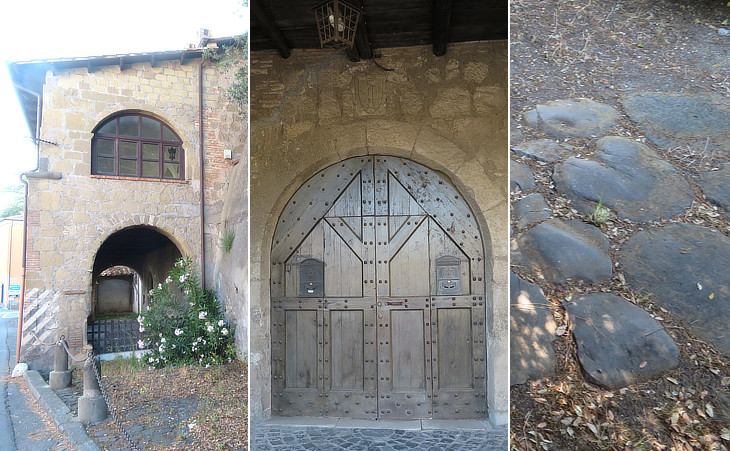
(left) Post house of Castelnuovo di Porto; (centre) portal with the coat of arms of the Colonna (a crowned column); (right) evidence of the ancient Roman road in the garden of the building
The fifth day in the morning, wee rode seventeene miles
to Castel' nuovo, through woody Mountaines, and Valies
of corne, in a way very dirty and slippery; and here our
Veturine tied to pay for our diet, put a new tricke upon
us, saying, that he would not dine, but goe on to Rome, yet if wee pleased to dine, hee would out of his duty
stay for us, otherwise being ready to finish the rest of his journey. We smiled at the knaves craft, and each
of us paied two paoli and a halfe for our dinners.
After dinner we rode thirteene miles to Rome (of old Rome,
the Head-Citie of the World) through winding hills and
pastures.
Fynes Moryson - An Itinerary: Containing His Ten Years Travel (Rome in 1594)
From Prima Porta eight miles further riding brought us to a small town called Castel novo, where we lodged. All this afternoon we rode near the Tiber upon the Via Flaminia. It is paved with broad flints and pebbles, and hath on each side a border of stone, and in that border at every second or third place a stone standing up higher than the level of the border. We observed in the fields we passed through this day great store of vernal crocuses now in flower.
John Ray's Observations (..) made in a journey through part of (..) Italy in 1663

An isolated tufa rock near Morlupo
March 1740. Besides, my dear Neuilly, I am too impatient to join you to amuse you with trifles. In favour of this purpose, you will not be unhappy with me for having already passed by Castelnuovo, Regnano and Civita-Castellana without saying anything. So there is nothing worth the trouble. One has the honor of being broken all the way by the Via Flaminia, which is one of the hardest antiquities I know.
Charles de Brosses - Lettres familières écrites d'Italie en 1739 et 1740
The face of the country the first three posts from Rome, is disgracefully uncultivated; no villages, no habitations - (except post-houses), nothing but a dreary dismal waste - without track of man or beast to be seen.
Anna Miller - Letters from Italy - 1771
This, I am convinced, is the only country in the world, where the fields become more desolate as you approach the capital. After having traversed the cultivated and fertile vallies of Umbria, one is affected with double emotion at beholding the deplorable state of poor neglected Latium. For several posts before you arrive at Rome, few villages, little cultivation, and scarcely any inhabitants are to be seen.
John Moore - View of Society and Manners in Italy (in 1775) - publ. 1781
Most XVIIIth century travellers found the last leg of Via Flaminia very boring and desolate.
J. W. Goethe to the contrary was impressed by the landscape he saw: The streams tearing through this volcanic region have
formed out of it hills and rocks, which, with their overhanging ledges, and other marked features of the landscape,
furnish most glorious objects for the painter.
Italian Journey - October 28, 1786 - Translation by Charles Nisbet.

Inscription on Palazzo Miselli Faccini at Castelnuovo di Porto
Grand Tour travellers were not the only users of Via Flaminia; during the Succession Wars (1701-1748)
several armies followed this road to reach the Kingdom of Naples: in 1734, at the age of 18, Don Carlos (Charles of Bourbon),
Duke of Parma, commander of a small army, led his troops along this route on their way to conquer that kingdom:
he spent a night at Castelnuovo di Porto and the event was celebrated by a lengthy inscription.
In 1787 this stretch of Via Flaminia lost importance because Pope Pius VI
opened a new road between Civita Castellana and Monterosi
(which is located along Via Cassia) and travellers reached Rome by the new road.

View of Castello Boncompagni Ludovisi and of the bell tower of Immacolata Concezione di Maria, the parish church (Monte Gennaro in the distance)
Riano. A village not far from the ancient city of Capena,
consisting at present of three hundred and forty-six inhabitants. The country is very agreeably disposed in
pretty hills and woods, and near the village it is well
cultivated. Riano, indeed, is one of the most picturesque spots imaginable. The castle of the feudal
proprietor, now the Prince of Piombino, and the village,
occupy the summit of a tufo rock, precipitous on every
side. This rock is detached from the neighbouring hills
by deep glens prettily wooded, and the precipices have
been hollowed into caves - probably the sepulchres of the ancient inhabitants.
A road runs from the Via Flaminia to Riano, passing by the Capuchin convent, built by Cardinal Pier Donato Cesi in
the sixteenth century. (..) In the foundation of a house at
Riano is the fragment of an altar, of white marble, and
highly ornamented, perhaps the Ara Jani, (whence the
name Riano may be derived).
Sir William Gell - The Topography of Rome and its vicinity - 1846 ed.
Riano is not visible from Via Flaminia, thus no reference to it was made by the travellers to and from Rome.

(left) Main gate; (right) coat of arms of (left) Francesco Maria Ruspoli, Prince of Cerveteri and of (right) Isabella Cesi, his wife; a similar c.o.a. can be seen at Vignanello, north of Civita Castellana
For many centuries Riano was a property of Monastero di S. Paolo fuori le Mura, similarly to nearby Civitella S. Paolo and Leprignano. The medieval castle at its western end was turned into a palace by the Cesi, who acquired Riano and Cantalupo in 1571. The Cesi, a family from Umbria, had several branches one of which was named after Riano or other fiefdoms in Latium, and another from Acquasparta near Todi. Riano was acquired by the Ruspoli through marriage and in 1713 Prince Francesco Maria Ruspoli placed a grand coat of arms of the two families on the only gate of the town.
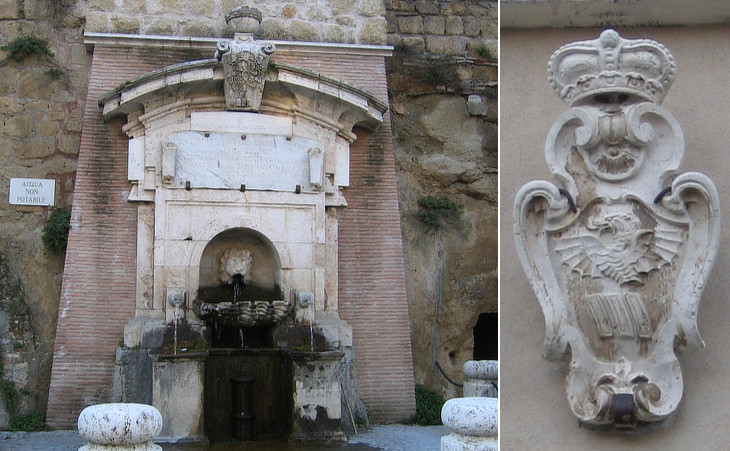
(left) Fountain; (right) coat of arms of the Boncompagni Ludovisi on a building
In 1730 Prince Ruspoli built a fountain at the foot of the tufa rock; it bears just his coat of arms: you can see it in the image used as background for this page. In 1818 the Ruspoli sold Riano to Luigi I Boncompagni Ludovisi who had received a huge compensation for having ceded Piombino to the Grand Duchy of Tuscany.

Immacolata Concezione di Maria: detail of the 1738 ceiling: (left) coat of arms of Cardinal Bartolomeo Ruspoli
(associated with the coat of arms of Pope Clement XII who appointed him cardinal in 1730);
(right) coat of arms of the Boncompagni Ludovisi which was added in the XIXth century
You may wish to see a page with a list of the historical Roman families and their possessions.

View from Via Flaminia
Castel Nuovo. A town of 867 inhabitants, situated about nineteen
miles from Rome, half a mile to the left of the Via
Flaminia, and nearly four miles from Riano. It may
be clearly seen from the road, but has nothing remarkable to distinguish it. The hill on which the town is built (like most of those selected as a site for towns) is joined to the highland by an isthmus; but is precipitous to the south.
In position and appearance, it greatly resembles Morlupo, distant two miles. Gell
The reference to Porto in the name of Castelnuovo is due to the town being included
into the ancient diocese of Porto, which was held by a senior Cardinal. Castelnuovo was for many centuries a fiefdom of the Colonna, a very powerful family whose properties however were mainly south of Rome, whereas the Orsini had most of their fiefdoms north of Rome, including Fiano Romano, very near Castelnuovo.

Castello Colonna
The redesign of the castle and the improvements made to Via Flaminia were promoted by Clarice Colonna Anguillara (1545-1591) after the death of Sciarra Colonna, her husband, and of her two children. She belonged to a local noble family and she was a very pious woman. The upper part of the building includes a (closed) loggia with frescoes which are attributed to Federico Zuccari, who at that time was involved with his brother Taddeo in the decoration of Palazzo Farnese di Caprarola.
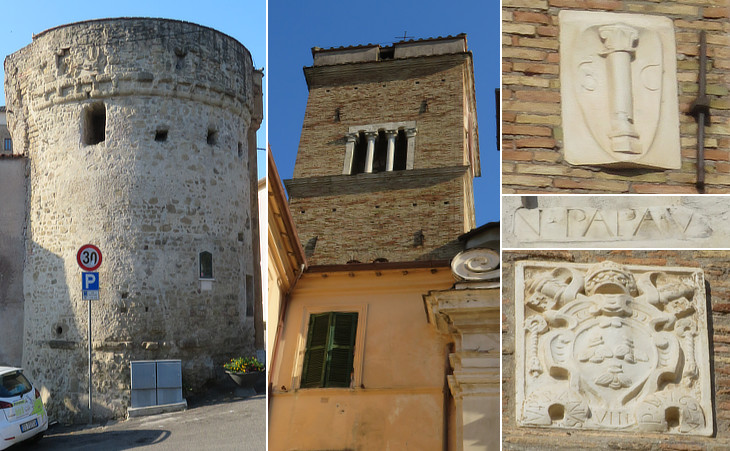
(left) Round Renaissance tower at the entrance to the medieval town; (centre) bell tower; (right-above) coat of arms of the Colonna (S.C. Sciarra Colonna); (right-middle) inscription below a lost c.o.a. of Pope Nicholas V; (right-below) c.o.a. of Pope Urban VIII
Towards the end of the XVIth century the Colonna had significant financial difficulties (more on this following this link) and at the death of Clarice, Castelnuovo became a direct possession of Camera Apostolica, the body of the Papal State in charge of the fiscal system. This explains why in 1624 a coat of arms of Pope Urban VIII was placed on one of the side walls of the castle.
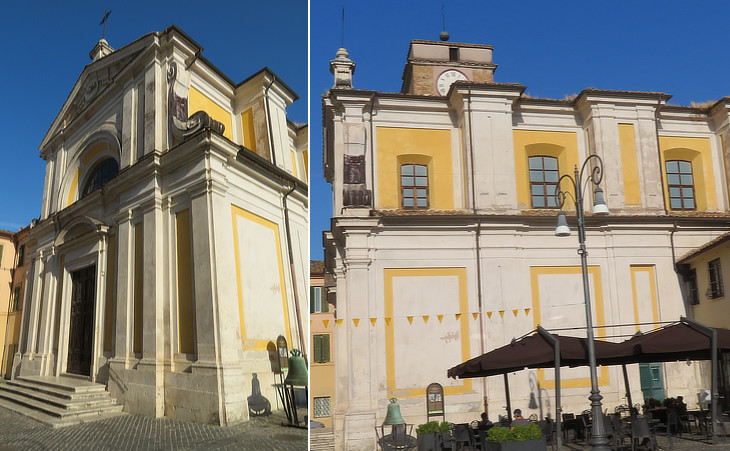
Collegiata di S. Maria Assunta
Advancing you come to the little town of Castel Nuovo, which is a poor place containing nothing remarkable except a handsome church in honour of the virgin. (..) The rest of the country from hence to Rome is untilled and almost without inhabitants.
Thomas Nugent - The Grand Tour - 1756 edition
Porto was a "suburbicarian" (in the vicinity of Rome) diocese and it was assigned to a senior cardinal, usually the Vice Dean of the College of Cardinals. The main church of the town was rebuilt in 1753-1756 at the initiative of Cardinal Raniero d'Elci (see his tomb at S. Sabina) and of Cardinal Giovanni Antonio Guadagni, of a historical noble family from Florence, his successor as Bishop of Porto.
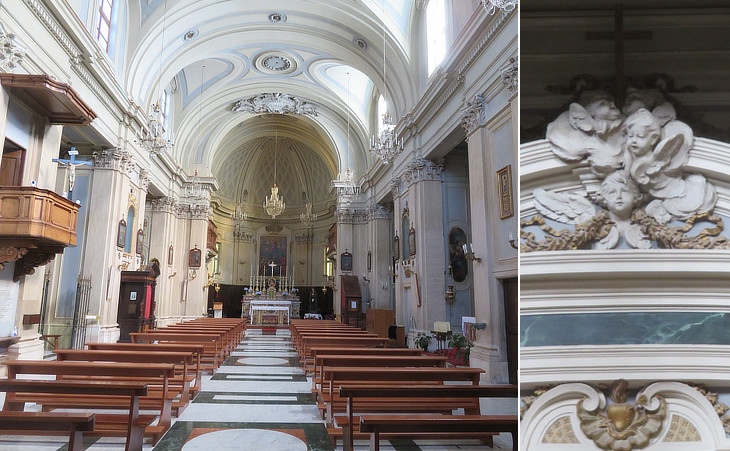
Collegiata di S. Maria Assunta: (left) interior; (right) a detail of its stucco decoration
The interior of the new church had a very grand Roman aspect which calls to mind those of S. Cecilia in Trastevere and S. Croce in Gerusalemme, two historical churches which were redesigned in the XVIIIth century, in particular for its rich stucco decoration.
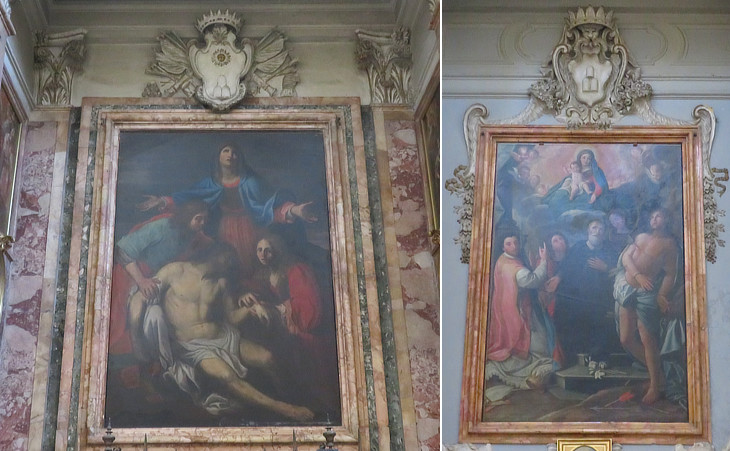
Collegiata di S. Maria Assunta: (left) Cappella Paradisi: Pietà (Lamentation) attributed to Annibale Carracci (see the same subject in a painting by Carracci at Palazzo Barberini); (right) Assumption of Mary, St. Sebastian and other saints (XVIIth century)
The Paradisi were a family from Terni where they had a finely decorated chapel. They had some properties at Castelnuovo, where some descendants still live. An inscription records that Giovanni Antonio Paradisi placed a painting by Annibale Carracci in the chapel in 1757. Today it is regarded as a work by Carracci's assistants, with perhaps the image of the Virgin Mary by the great painter.

(left) S. Maria delle Virtù; (right) SS. Agostino e Antonio Abate
S. Maria delle Virtù is a church outside the walls of the town along the road leading to Via Flaminia. The name refers to the "virtues", in the sense of powers of performing miracles, of a holy image of the Virgin Mary. The church was built in 1674 to properly house the image. In 1904 t
it was closed because it was about to collapse and in the following years the painting on the main altar was stolen.
St. Anthony the Hermit aka the Abbot was worshipped in many small towns of the Roman countryside as patron of the domesticated animals. In this case however he was referred to because monks of the Order of St. Anthony played a particular role in treating ergotism, an illness brought on by the ingestion of fungus-contaminated rye grain causing ergot poisoning and commonly known as St. Anthony's Fire. The small church along Via Flaminia which was dedicated to him and to St. Augustine was part of a hospital which was founded by Clarice Colonna Anguillara to assist the pilgrims and treat this disease on their route to Rome. In 1756 Cardinal Guadagni promoted its very elegant redesign.
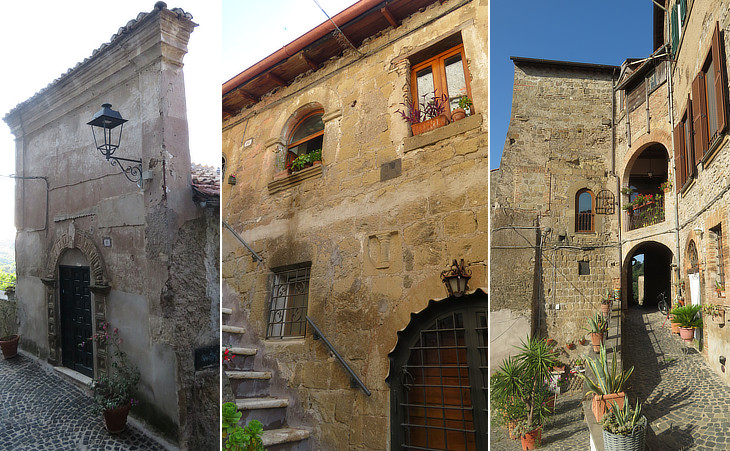
Strolling behind the castle: (left) a small chapel which has been turned into a house; (centre) an old house with the Colonna heraldic symbol; (right) a passage along the walls
The historical part of the town was neglected for most of the XXth century because it could not be easily reached by car, but in recent years this aspect has become a positive one, and many small houses have been restored and are second homes for Italians and foreigners.
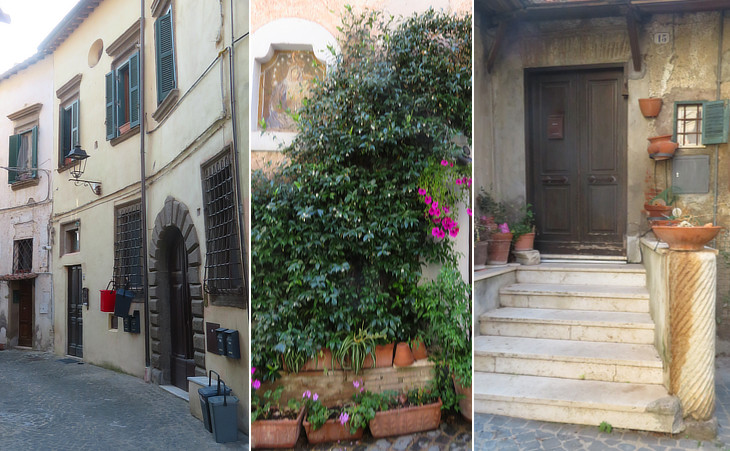
Strolling behind the castle (2): (left) a Renaissance palace; (centre) a sacred image; (right) an ancient column

Strolling in Castelnuovo in January 2008
Move to Morlupo and Leprignano (Capena) or to Lucus Feroniae or to Villa dei Volusii.

